I held off on writing another “yard list” post until I’d met my self-imposed deadline of June 30 for updating the fly chapter of my leafminer book. Now that that’s out of the way, I’ve got some catching up to do… but before I get to that, if you missed my leafminer webinar last week, you can check out the recording here. Also, I’ll be doing a more general presentation on plant-feeding insects (but of course with leafminers sprinkled throughout) on July 10; you can sign up for that here. Okay, here goes…
Back on June 20, I stepped out my front door with a camera or two, planning to contribute a little to a statewide bioblitz that was happening that weekend. The first insect I saw was an agromyzid fly that appeared to be ovipositing on the white vervain (Verbenaceae: Verbena uticifolia) that is growing right against the doorstep. I assumed it would be Calycomyza verbenae, another leafminer for this year’s list, but when I looked more closely I saw that it was a Melanagromyza:

Melanagromyza species are stem borers and seed feeders rather than leafminers, but this was still interesting because the only previous records of Melanagromyza from Verbena in North America are 1) a single male of an apparently undescribed species extracted from a stem of V. scabra in Florida about 50 years ago, and 2) a few specimens John van der Linden reared from V. stricta in Iowa three years ago, which are being described as a new species in a paper that is currently in review. That species feeds in both the stem and in the rachis of the inflorescence.
So if Melanagromyza species aren’t leafminers, why was this one ovipositing in a leaf? She wasn’t. She was “host-feeding”: using her piercing ovipositor to create tiny wounds in the leaves and then drink the juices that oozed from them.

Female agromyzids are pretty well useless taxonomically, so I let her go about her business while I turned my attention to other bugs on and around the stoop. She kept at it for at least another 15 minutes; I usually can’t be bothered with stem-boring insects, but I’ll have to see if I can rear anything from that vervain plant now that I’ve seen a mysterious insect take such a keen interest in it.
There was a fancy iridescent darkling beetle (Tenebrionidae: Tarpela micans) sitting in an otherwise empty bucket on the stoop…

…and a bush katydid nymph (Tettigoniidae: Scudderia), long-legged fly (Dolichopodidae: Condylostylus), and parasitoid wasp resting on jewelweed leaves overhanging the stoop…



…and a paper wasp (Vespidae: Polistes fuscatus) and four-lined plant bug (Miridae: Poecilocapsus lineatus) hiding among the leaves of a mullein plant growing right next to the stoop…
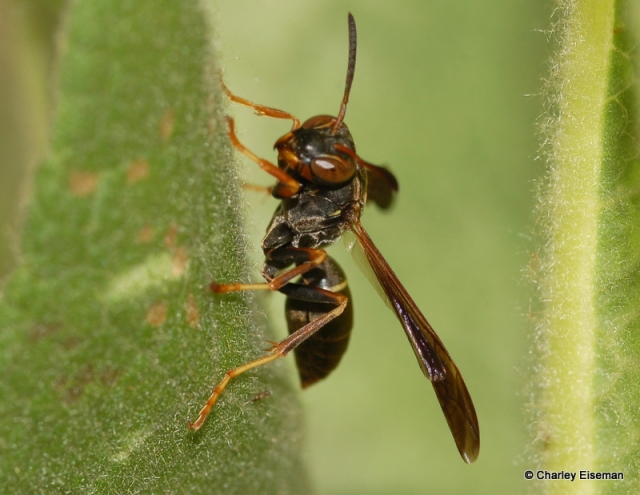

…and then I noticed a brown patch at the edge of a leaf in the big patch of oregano growing next to the stoop.
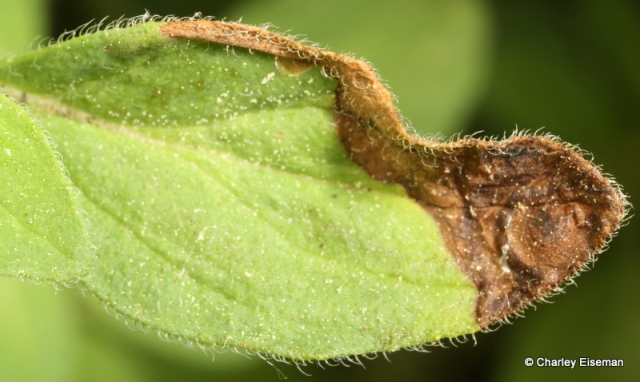
A leaf mine? Backlighting it confirmed that it was—note the puparium at far left:

I checked my book to see which of the mint-feeding agromyzids this would be. No mention of oregano (Origanum) whatsoever in the Lamiales chapter. So I checked the European leafminer website and found a match: Phytomyza origani. My one hesitation in identifying this mine as such was that the examples on the website all showed a narrow initial linear portion. Hunting around a bit more, I found some like that in my oregano patch:

So not only the 81st leafminer species for the yard list, but a new species for North America! It’s surprising that a “pest” of a common cultivated plant would have gone unnoticed, but I found just a few mines after checking our several large oregano patches, so it seems that this fly has been flying under the radar by existing at very low densities, and by forming mines that often just look like random brown patches at the edges of leaves. Its “damage” to the plants in my yard is certainly negligible; the feeding sign of the four-lined plant bugs is much more conspicuous (but still has no impact on our ability to use the oregano, as far as I’m concerned).
Finally exploring the yard beyond the front stoop, I noticed some Eulophus adults emerging from the “tombstone pupae” I’d found back on the 13th.

I saw several adults of Argyresthia thuiella on the arborvitae hedge, so I can stop feeling guilty about having included this species on the list even though every mine I found with a larva inside turned out to be Coleotechnites thujaella.

You may recall that back on May 28, I found two cocoons on the arborvitae that I believed to belong to Argyresthia aureoargentella.

I collected them with the hope of rearing an adult, but my chances of succeeding were cut in half when this microgastrine braconid emerged from one of them on June 6:


On the evening of June 20, I was surprised to see a large amount of frass in the vial that contained the remaining cocoon. The source turned out to be this sawfly larva:

I’m either extremely lucky that the little piece of arborvitae I collected with that cocoon happened to have a sawfly egg in it, or these larvae are extremely abundant and I’m just very bad at seeing them, because I’ve been scouring the hedge for them ever since I saw this Monoctenus female ovipositing back on May 18, and I have yet to find one.

Whatever the explanation, I’ll count this as the 24th type of sawfly larva found in my yard this year. By June 25, it had developed some longitudinal stripes:

Even though I offered it a fresh sprig of arborvitae, it continued to eat the month-old sprig with the cocoon on it. Here it is with the cocoon the next day:

I discovered yesterday that it had eaten the cocoon. So much for that.
You also may recall that on June 6 I had collected an underside tentiform mine on a paper birch leaf, and the next day the larva had revealed itself to be a Parornix when it emerged from the mine and began using silk to create a marginal leaf fold in which it continued to feed.

Well, we’ll never know which species of Parornix this was, because on June 20 a microgastine braconid emerged from that too. I’m pretty sure the wasp is a Pholetesor species based on its characteristic cocoon that was suspended within the moth larva’s leaf fold.


Leafminer #82: Chirosia flavipennis (Anthomyiidae). On June 21 I noticed this little mine on a bracken fern (Dennstaedtiaceae: Pteridium aquilinum) in the front yard. The white egg on the underside identifies its maker as a fly in the genus Chirosia, and of the species known to feed on bracken it is most likely to be C. flavipennis. Impressive that its mother managed to find one of the two bracken fronds in our whole yard, which are a byproduct of our having a few years ago transplanted some lowbush blueberry and huckleberry plants from a conservation area in town just before they would have been destroyed to make way for a wheelchair-accessible trail.


Leafminer #83: Phyllonorycter blancardella (Gracillariidae). On the old apple tree by the chicken coop I found a few underside tentiform mines of this moth:


An adult emerged from one of them two days later:

Leafminer #84: Bohemannia pulverosella (Nepticulidae). The apple tree also had a single mine (that I noticed) of this tiny moth, which was only recently discovered in North America. As with Phytomyza origani, I suspect that it has been around for a while and just hasn’t been causing anyone any problems.

Sawfly #25: This one was on a white avens leaf (Rosaceae: Geum canadense) right under the old apple tree. No idea yet who it might be.

Sawfly #26: Caliroa sp. (Tenthredinidae). About a decade ago at the Montague Plains in western Massachusetts, George Leoniak asked me about some larvae that were window-feeding on the underside of a leaf of quaking aspen (Salicaceae: Populus tremuloides). I recognized them as Caliroa “slug” sawflies, but no Caliroa is known to feed on Populus. I’ve been regretting ever since that I didn’t collect those larvae and try to rear them; I’ve checked a lot of aspen leaves and have never found any further evidence of their existence… until ten days ago, when I noticed patches like this on the little quaking aspen sapling in our “lower nut orchard.”

Flipping the leaves over, I found Caliroa exuviae on the lower surface, but alas, there were no actual larvae remaining.

Nearby I spotted a well-concealed red-eyed vireo nest in a grapevine. I’m honored that this bird flew all the way from the Amazon to weave this little work of art in my yard.


Sawfly #27: These larvae were feasting on a leaf of one of our cultivated hazelnuts. They are tenthredinids rather than the big Arge species that shows up on our hazelnuts every year, but I’m not sure exactly what they are.


These larvae have now all finished feeding and spun cocoons. There was one straggler left on June 29:

Still in the “lower nut orchard,” I found a couple of these snazzy sawfly larvae on late goldenrod (Asteraceae: Solidago gigantea):

I won’t count these as a new type, because the tiny, plain larva I found on Canada goldenrod two weeks ago (shown at the end of this post) now looks exactly like this.
Leafminer #85: Bucculatrix angustata (Bucculatricidae). These little blotches on a leaf of calico aster (Asteraceae: Symphyotrichum lateriflorum) were made by a larva of this moth after exiting its initial linear mine.

On June 22, I was somewhat disappointed to see that an ichneumon wasp had emerged from a sumac twig into which one of the black-headed lady fern sawfly larvae had bored a week or so earlier. Then I was excited to realize that it was actually a sawfly that just looked like an ichneumonid:

It appears to be Thrinax albidopicta, which has been associated with sensitive fern (Onoclea sensibilis) but not lady fern (Athyrium angustum) as far as I know. Five adults of the pussy willow sawflies emerged on the same day; I’m still not sure exactly what they are.

When I checked on June 26, I found larvae of the second generation feeding away on the same pussy willow:

On June 23, I checked the wee bigtooth aspen sapling in the front yard, from which I had collected five nematine sawfly larvae on May 31, and this time I found five Caliroa “slugs” on it—presumably the same species that had already come and gone on the quaking aspen sapling.

Feeding on the undersides of leaves was a good strategy for these larvae, given that the sapling was in full sun in the middle of a string of 90°F days when I found them. While I was photographing them, a tree swallow was relentlessly dive-bombing me, as he had taken to doing once there were nestlings in his box.
I got some more photos of these larvae indoors a few days later. At the right angle, you can see that there are little faces and legs hidden under those slimy bodies:

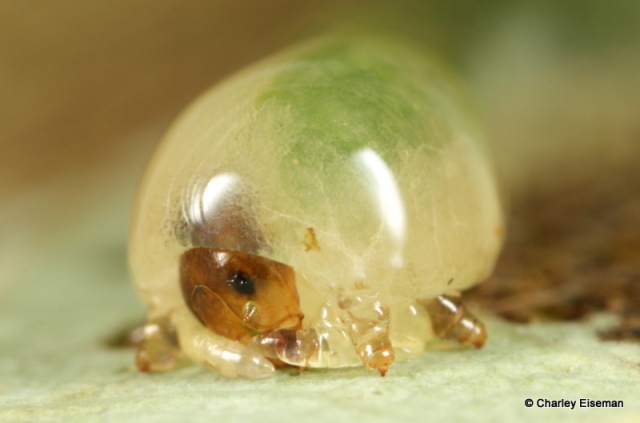
Leafminer #86: Mantura floridana (Chrysomelidae). I found a few vacated mines of this beetle in a clump of yellow wood-sorrel (Oxalidaceae: Oxalis stricta) along the road. The “normal” hosts of M. floridana are plants in the buckwheat family (Polygonaceae), which like wood-sorrel have a sour flavor due to the presence of oxalic acid. This is the first time I’ve seen them using Oxalis in New England.

Also on June 23, this ichneumonid (Gelis, or so) emerged from the Coleophora pruniella case I had found on a grape leaf on June 9.


On June 26 I found two sawfly larvae eating leaves of our cultivated strawberries. I suspect they’re the same species that I found on white avens, since at least one of those two had a head pattern like this at one point.

On the other hand, I won’t be surprised to learn that they are two different species, because there was a definite behavioral difference. Whereas both of the avens larvae just sat there dopily while I photographed and collected them, both of the strawberry larvae quickly curled up and dropped to the ground as soon as I bent down to look at them.
A visit to our largest red oak sapling (the one that had all the Acordulecera larvae back at the end of May) added two new leaf-mining moths to the list.
Leafminer #87: Stigmella quercipulchella (Nepticulidae). This particular larva was dead for unknown reasons, but I saw several healthy yellow larvae feeding away during a walk in the woods yesterday.

Leafminer #88: Bucculatrix sp. (Bucculatricidae). No telling which of the many oak-feeding species made these tiny mines, but clearly something other than the two aster-feeding species I’ve listed so far this year.

There were numerous Bucculatrix mines and I spent a little while unsuccessfully looking for older larvae feeding exposed on the undersides of the leaves. I did see some of their feeding sign and empty molting cocoons though.

A little black cherry sapling added another two moth species.
Leafminer #89: Stigmella prunifoliella (Nepticulidae). The larva that made this mine was extracted by an ant or some other predator when it was nearly mature.

Leafminer #90: ?Phyllonorycter crataegella (Gracillariidae). The much smaller size distinguishes this underside tentiform mine from that of P. propinquinella, the other possibility on black cherry—unless it turns out to be a Parornix.

Leafminer #91: Phyllocnistis vitegenella (Gracillariidae). When I waded into the little wild area between the front yard and the “upper nut orchard” to pull up a bittersweet vine, I spotted the first “snail trail” mine of this species on a riverbank grape leaf.

Sawfly #28: Pristiphora appendiculata (Tenthredinidae). I had listed this as sawfly #15 back on June 15, but I corrected that a few days later when I realized the hatchlings I collected were developing into Nematus ribesii. On June 26, I found an actual P. appendiculata larva on the same red currant bush.

There happened to be a Nematus ribesii larva munching on the other side of the same leaf.

Two days later I noticed the little buggers defoliating our gooseberry bush.

On June 14 I wrote about the paper birch sawfly larva that appeared in a rearing jar at the same time that 29 adults were emerging from the leaves collected on May 31. It didn’t have a pink butt like all the larvae I’d originally collected, but then later it did have a pink butt but also had longitudinal stripes and was much larger than the original larvae. Well, that larva emerged as an adult on June 26.
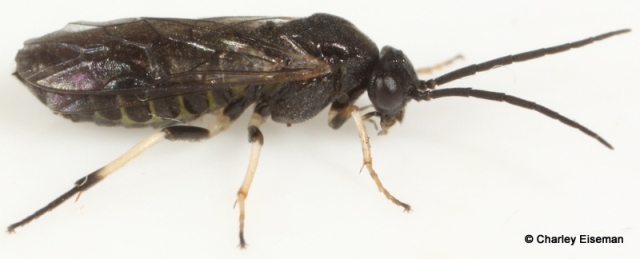
It looks an awful lot like all the others, but as with the larva it is much larger. I look forward to hearing what Dave Smith has to say when he examines the specimens.
Also on June 26, a microgastrine braconid appeared in the jar of pin cherry leaves I’d collected on June 17 with the hope of confirming that the mines and rolls on them were the work of Caloptilia invariabilis.

Sawfly #29: Waldheimia carbonaria (Tenthredinidae). On June 27 I noticed some tattered leaves on an evening primrose (Onagraceae: Oenothera biennis) growing along the front of the house, and found these larvae to be the cause:

I first noticed larvae of this species in my yard in September 2016, and had adults emerge the following spring:

Leafminer #92: Liriomyza asclepiadis (Agromyzidae). These beloved milkweed specialists finally made their appearance in my yard on June 28.

On June 29 one of the plain-headed lady fern larvae emerged as an adult. It turns out to be Aneugmenus flavipes, a species previously associated with bracken fern.

The same day, this Parornix emerged from one of the smooth shadbush (Amelanchier laevis) leaves I’d collected with sawfly larvae on June 12.

A look at Dietz’s (1907) key to this genus reveals that… yup, it’s a Parornix. Maybe quadripunctella? That species does feed on shadbush; depending on how I interpret the key, I could also land on strobivorella or vicinella, but the former is supposed to feed on mountain-ash (Sorbus) and the latter on birch (Betula).
Leafminer #93: Phyllocnistis liriodendronella (Gracillariidae). The much needed rain over the past several days has kept me from looking for new leafminers, but I noticed the initial spirals of this species on the magnolia by the front stoop yesterday morning.

Y’all can keep calling this Phyllocnistis magnoliella for now if you want, but Don Davis and I have decided to synonymize that name under P. liriodendronella (the tuliptree miner), for reasons I won’t go into here.
Also, yesterday the adult Marmara fraxinicola emerged from the white ash bark mine I collected back on May 22:

And finally, the latest additions to the list of plants I’ve eaten in the yard this year. The drought has deprived us of some of the tree fruits we were looking forward to harvesting later in the season, but the shrubs have held onto their fruits just fine.
68. Wild strawberry (Rosaceae: Fragaria virginiana) – fruit
69. Purslane (Portulacaceae: Portulaca oleracea) – leaves & stems
70. Red currant (Grossulariaceae: Ribes rubrum) – fruit
71. White mulberry (Moraceae: Morus alba) – fruit
72. Goumi (Elaeagnaceae: Elaeagnus multiflora) – fruit
73. Red raspberry (Rosaceae: Rubus idaeus) – fruit


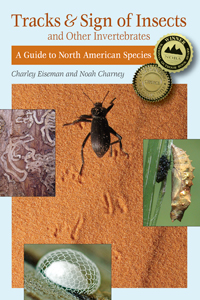
Wonderful bio-tour! Thank you.
Sent from my iPhone
>
Pingback: The Yard List(s), Part 20 | BugTracks
Pingback: More and more | BugTracks
Pingback: Another writing season begins! | BugTracks
Pingback: Hazelnut Sawflies | BugTracks